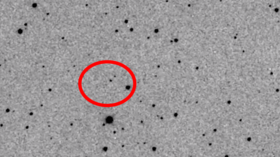UFO ‘trash bag’ orbiting Earth triggers asteroid defense telescope (VIDEO)

Keen-eyed astronomers based in Hawaii have spotted what can only be described as a “trash bag” UFO orbiting the Earth in a rather unusual fashion.
The space bag was first spotted by the Asteroid Terrestrial-impact Last Alert System (ATLAS) telescope in Haleakala, Hawaii on Friday. ATLAS is one of a select few telescopes tasked with monitoring near-Earth objects (NEOs) to warn us of any impending danger, though this particular object does not appear to pose any threat but is perplexing nonetheless.
It has since, rather unenthusiastically, been named A10bMLz, as opposed to the now-traditional ‘Baggy McBagface’ that so many netizens would no doubt have wished for.
The Northolt Branch Observatories in London managed to film the space bag, which is believed to be several meters in diameter while weighing as little as 2.2 pounds (1 kilogram), fuelling speculation that it is likely just leftover foil from a rocket launch.
The space bag is one of roughly 500,000 individual pieces of debris which orbit the planet; approximately 200 to 400 of which burn up in our atmosphere each year according to NOAA calculations.
Also on rt.com Lucky strike? Moment meteorite slammed into Super Blood Wolf Moon caught on camera (PHOTO, VIDEO)So, while it is not the first “empty trash bag” to be spotted by astronomers one peculiarity about it does stand out: at its closest point, the space bag comes within 600km (373 miles) of the Earth’s surface at closest point before extending out beyond the moon at farthest point.
Its orbit is unpredictable given its light weight, which means it will likely be blown off course by solar radiation and burn up in the Earth’s atmosphere within the next few months.
Like this story? Share it with a friend!















